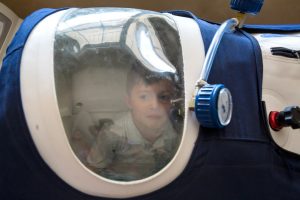Photography Book, ‘An Ordinary Day,’ Portrays Kids with Rare Genetic Diseases

Karen Haberberg's new book, "An Ordinary Day," portrays 27 American families living with children who have rare genetic conditions.
Karen Haberberg, a New York portrait photographer, has taken tens of thousands of pictures throughout her career of families, couples, pregnant women, teenagers, and fashion models — not to mention dramatic landscape shots from Iceland to Indonesia.
She’s also done several personal photo projects, including “Benjamin,” a haunting portrayal of her father’s experience as a Holocaust survivor in Poland, and “Kenny,” which profiles a young farmworker with severe congenital disabilities.
Haberberg’s latest project, however, focuses only on children with rare genetic disorders.
“An Ordinary Day” presents the stories of 27 families living with kids like Ethan, a young boy with Angelman syndrome; Tara, a teenage girl who has both Crohn’s disease and juvenile rheumatoid arthritis; and Jamesy, a 7-year-old with Duchenne muscular dystrophy.
The hardcover volume went on sale Oct. 24 and retails for $45. Proceeds from sales will go to fund research on treatments for rare genetic diseases.
According to a blurb on Haberberg’s website, the book “gives a voice to families raising children with rare genetic disorders. Despite the complexity of their individual circumstances, the book — featuring photographs, interviews and a list of informative resources — captures family life in all its simplicity and humanity.”
Haberberg said the idea for her ambitious project sprang from deep personal loss.
“My brother died of Tay-Sachs disease in 1969, so I was always interested in genetics,” Haberberg told Angelman Syndrome News in a phone interview from New York. “More recently, my best friend had a child with Angelman syndrome, and in watching her struggle and hearing day to day what she was going through, I felt like I needed to do something for this community. My first shoot was a family in New Jersey that had a child with Tay-Sachs.”
Haberberg decided to contact Global Genes, a nonprofit advocacy organization, which publicized her project on its own website.
“People just started coming to me,” she said. “I then ran a Kickstarter to raise money to travel, and spent a lot of time photographing in California and on the East Coast.”
Asked how the children reacted to her work, Haberberg — who has two kids of her own, Maya and Liam — said: “I’m really there more as an observer. I don’t set up any of these shots. A lot of these kids are not even aware that I’m photographing. So it’s more about just respecting the families and what they’re doing. I try and just fit in.”
Haberberg spent two years on the endeavor, narrowing more than 10,000 photos down to a final selection of 103 that appear in the coffee-table book.
“The people who contacted me really wanted to tell their stories. They’re very pro-active about their kids,” she said. “Unfortunately I had to end up turning people away because I couldn’t afford to visit everybody.”
Haberberg, a New York native, got her bachelor’s degree in sociology at Brandeis University, then earned a master’s in art and technology from New York’s International Center for Photography (ICP). She also did a six-month stint at Tel Aviv University in Israel and now teaches at New York University, the 92Y and the Jewish Community Center of Manhattan.
She’s curated numerous exhibitions, and her work has appeared in many newspapers and magazines, including the Wall Street Journal, New York Family Magazine, Fit Pregnancy, and Time Out New York.
“The book’s been incredibly well-received,” said Haberberg, who shoots with a Canon EOS 5D Mark IV digital camera as well as a Sony A7R3 full-frame mirrorless camera. “I had an opening event and got lots of press. It’s a difficult subject, I think, but it’s really important for people to be aware how common rare genetic diseases are.”









